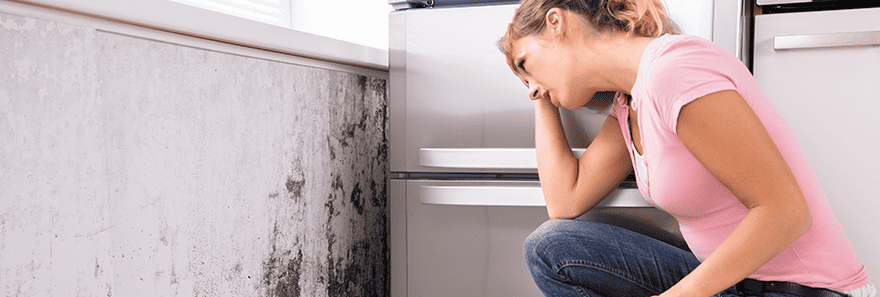Discovery of Mold in Your Home
Picture this: it’s laundry day at your home. Just as you are about to finish folding your towels, you notice a dark, blotchy spot on the wall that appears to proceed from the top of the appliance and continues down the wall to what seems to be floor level. You grab a flashlight and manage to move the washer just enough to point the beam behind the unit to discover a large swath of mold that almost covers the entire wall behind your laundry units.
You’re Not Alone
Unfortunately, this scenario can happen to just about anyone, as mold can be found virtually anywhere: indoors, outdoors, in the air, on the ground, with green eggs and ham; you name it. Mold travels from place to place among microscopic facilitators known as spores, and due to their very small size, they can quickly adapt and attach themselves within every nook and cranny in your home- especially those areas that see moisture. Believe it or not, mold can be carried in on your pets, your clothes, and even in your lungs and then exhaled out later. When the spores settle on a place with the perfect conditions (typically damp, dark areas of the home previously damaged by water), they can begin repopulating in a concentrated form and that’s when the real issues arise. Mold fungus can lead to permanent damage to the dwelling and even affect the health of the occupants within. Most of the time, the health effects are limited to symptoms that are in line with allergies, but some mold types can cause bronchitis and even life-altering lung conditions such as COPD and cancer have occurred. Mold infections can be particularly troublesome to those that already have respiratory disease present.
Thankfully, with the right information, you can prevent any of these things from happening to you and your home. The CDC and EPA’s websites both have detailed lists of what types of common molds may be found in your area, from Aspergillus to Mucor to Penicillin. They vary in size, colorization, and shape, but most are distinctly off-color, like a stain that has taken on a life of its own. Sourcing the EPA’s Guide to Mold would give you a more exact picture of matching what you’re dealing with and how it got there, but nearly all molds form from two common sources: water damage or moisture build-up from condensation. Like the laundry room scenario, many types of mold are found along ducts or drainage for appliances, typically those that deal with flushing fluids. Bathrooms, kitchens, and laundry rooms are the most common areas, but oftentimes a leak from a different floor or even an adjoining unit, like in a condo or townhome, can lead to mold developing in your bedroom or living room. It can also lurk within your carpets, hardwood, and flooring materials, so leave no stone unturned when inspecting a new home or checking your home annually as a preventative measure.
Your Next Steps
If you think you might have stumbled upon a moldy area, you’ll first need to dispose of everything touching the mold to prevent a further spread of the damage through mold spores. Leaving a dehumidifier on or simply airing out the room will help slow down the process, but if mold is found, it’s best to leave it up to the professionals to remove it permanently. Professional disaster cleanup companies can take the drying intensity to a whole new level, and in some cases use negative pressure to prevent the mold from surviving. Fungicides and other cleaners will be used to seal the area from future spores. Depending on the severity, the part of the room that was damaged may even have to be rebuilt. All-in-all, it’s a costly procedure for the homeowner. So, the best offense here is a good defense; after inspection, try to keep your humidity down and make sure air flows freely through all areas of your home. Avoid putting carpets in areas of high moisture, like kitchens, bathrooms, or basements, and when a leak should happen, make sure it is properly dried and dealt with right away. The vigilant practice of these tips will surely keep your house mold-free.
Do you suspect you have a mold problem in your home? Contact Us and we will send a qualified technician to your home to thoroughly inspect your home for mold and mold damage. If found, we’ll help you through the clean-up process all the way to a happy, healthy home.



